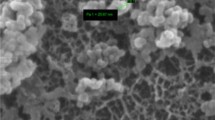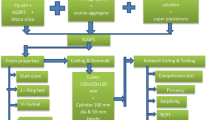Abstract
The effect of silica fume on the fresh and hardened properties of fly ash-based self-compacting geopolymer concrete (SCGC) was investigated in this paper. The work focused on the concrete mixes with a fixed water-to-geopolymer solid (W/Gs) ratio of 0.33 by mass and a constant total binder content of 400 kg/m3. The mass fractions of silica fume that replaced fly ash in this research were 0wt%, 5wt%, 10wt%, and 15wt%. The workability-related fresh properties of SCGC were assessed through slump flow, V-funnel, and L-box test methods. Hardened concrete tests were limited to compressive, splitting tensile and flexural strengths, all of which were measured at the age of 1, 7, and 28 d after 48-h oven curing. The results indicate that the addition of silica fume as a partial replacement of fly ash results in the loss of workability; nevertheless, the mechanical properties of hardened SCGC are significantly improved by incorporating silica fume, especially up to 10wt%. Applying this percentage of silica fume results in 4.3% reduction in the slump flow; however, it increases the compressive strength by 6.9%, tensile strength by 12.8% and flexural strength by 11.5%.
Similar content being viewed by others
References
B.V. Rangan, Fly Ash-based Geopolymer Concrete, Curtin University of Technology, Perth, 2010, p. 68.
J. Davidovits, Geopolymer cements to minimise carbondioxide greenhouse-warming, Ceram. Trans., 37(1993), p. 165.
J. Davidovits, Geopolymer Chemistry and Applications, 2nd Ed., Institut Géopolym`ere, Saint-Quentin, 2008, p. 276.
D. Hardjito, S.E. Wallah, D.M.J. Sumajouw, and B.V. Rangan, Factors influencing the compressive strength of fly ash-based geopolymer concrete, Civ. Eng. Dimens., 6(2004), No. 2, p. 88.
O. Boukendakdji, S. Kenai, E.H. Kadri, and F. Rouis, Effect of slag on the rheology of fresh self-compacted concrete, Constr. Build. Mater., 23(2009), No. 7, p. 2593.
C. Druta, Tensile Strength and Bonding Characteristics of Self-Compacting Concrete [Dissertation], Polytechnic University of Bucharest, Bucharest, 2003, p. 5.
European Federation of Specialist Construction Chemicals and Concrete Systems (EFNARC), Specification and Guidelines for Self-Compacting Concrete, EFNARC Association House, Surrey, 2002, p. 4.
M. Liu, Self-compacting concrete with different levels of pulverized fuel ash, Constr. Build. Mater., 24(2010), No. 7, p. 1245.
H. Okamura and M. Ouchi, Self-compacting concrete, J. Adv. Concr. Technol., 1(2003), No. 1, p. 5.
P. Nanthagopalan and M. Santhanam, A new empirical test method for the optimisation of viscosity modifying agent dosage in self-compacting concrete, Mater. Struct., 43(2010), No. 1–2, p. 203.
E.P. Koehler, Aggregates in Self-Consolidating Concrete [Dissertation], The University of Texas at Austin, Austin, 2007, p. 38.
H.A.F. Dehwah, Mechanical properties of self-compacting concrete incorporating quarry dust powder, silica fume or fly ash, Constr. Build. Mater., 26(2012), No. 1, p. 547.
K.C. Biswal1 and S.C. Sadangi, Effect of superplasticizer and silica fume on properties of concrete, [in] Proceedings of International Confence on Advances in Civil Engineering, Trivandrum, 2010, p. 94.
M.A. Caldarone, High-Strength Concrete: a Practical Guide, Taylor & Francis, New York, 2008, p. 43.
A.M. Neville, Properties of Concrete, 4th Ed. Wiley Publishers, New York, 1995, p. 844.
C. Meyer, The greening of the concrete industry, Cem. Concr. Compos., 31(2009), No. 8, p. 601.
S.A. Barbhuiya, J.K. Gbagbo, M.I. Russell, and P.A.M. Basheer, Properties of fly ash concrete modified with hydrated lime and silica fume, Constr. Build. Mater., 23(2009), No. 10, p. 3233.
F.A. Memon, F. Nuruddin, and N. Shafiq, Compressive strength and workability characteristics of low-calcium fly ash-based self-compacting geopolymer concrete, Int. J. Civ. Environ. Eng., 3(2011), No. 2, p. 72.
F.A. Memon, F. Nuruddin, S. Demie, and N. Shafiq, Effect of curing conditions on strength of fly ash-based selfcompacting geopolymer concrete, Int. J. Civ. Environ. Eng., 3(2011), No. 3, p. 183.
ASTM C618, Standard Specification for Coal Fly Ash and Raw or Calcined Natural Pozzolan for Use as a Mineral Admixture in Concrete, Annual Book of ASTM Standard, American Society for Testing and Materials, West Conshohocken, 2004, p. 2.
SS EN 450-1, Fly Ash for Concrete: Part 1. Definition, Specifications and Conformity Criteria, Swedish Standards Institute, Stockholm, 2012, p. 40.
BS EN 13263-1, Silica Fume for Concrete: Part 1. Definitions, Requirements and Conformity Criteria, British Standards Institute, London, 2005, p. 10.
ASTM C136, Standard Test Method for Sieve Analysis of Fine Aggregates, Annual Book of ASTM Standards, American Society for Testing and Materials, Philadelphia, 2004, p. 84.
BS 882: 1992, Specification for Aggregates from Natural Sources for Concrete, British Standards Institute, London, 1992, p. 14.
ASTM C33, Specifications for Concrete Aggregates, Annual Book of ASTM Standards, American Society for Testing and Materials, Philadelphia, 2004, p. 10.
European Federation of Specialist Construction Chemicals and Concrete Systems (EFNARC), The European Guidelines for Self-Compacting Concrete: Specification, Production and Use, The Self-Compacting Concrete European Project Group, Surrey, 2005, p. 47.
BS EN 12390-3, Testing Hardened Concrete: Part 3. Compressive Strength of Test Specimens, British Standards Institute, London, 2002, p. 5.
S. Mindess, J.F. Young, and D. Darwin, Concrete, PrenticeHall Inc., New Jersey, 2002, p. 315.
SS EN 12390-6, Testing Hardened Concrete: Part 6. Tensile Splitting Strength of Test Specimens, Swedish Standards Institute, Stockholm, 2004, p. 6.
ASTM C496/C496M-11, Standard Test Method for Splitting Tensile Strength of Cylindrical Concrete Specimens, Annual Book of ASTM Standards, American Society for Testing and Materials, Philadelphia, 2004, p. 287.
BS EN 12390-5, Testing Hardened Concrete: Part 5. Flexural Strength of Test Specimens, British Standards Institute, London, 2009, p. 5.
ASTM C78/C78M-10, Standard Test Method for Flexural Strength of Concrete, Annual Book of ASTM Standards, American Society for Testing and Materials, Philadelphia, 2004, p. 39.
K. Andri, Alkali-activation of Fly Ash/MIRHA Blend in Geopolymer Concrete for In-situ Application [Dissertation], Universiti Teknologi PETRONAS, Kuala Lumpur, 2012, p. 148.
S. Bhanja and B. Sengupta, Influence of silica fume on the tensile strength of concrete, Cem. Concr. Res., 35(2005), No. 4, p. 743.
J. Newman and B.S. Choo, Advanced Concrete Technology: Constituent Materials, Butterworth-Heinemann, Jordan Hill, Burlington, 2003, p. 48.
Z.X. Yang, N.R. Ha, M.S. Jang, K.H. Hwang, and J.K. Lee, The effect of SiO2 on the performance of inorganic sludgebased structural concretes, J. Ceram. Process. Res., 10(2009), No. 3, p. 266.
D. Dutta, S. Thokchom, P. Ghosh, and S. Ghosh, Effect of silica fume additions on porosity of fly ash geopolymers, J. Eng. Appl. Sci., 5(2010), No. 10, p. 74.
Author information
Authors and Affiliations
Corresponding author
Rights and permissions
About this article
Cite this article
Memon, F.A., Nuruddin, M.F. & Shafiq, N. Effect of silica fume on the fresh and hardened properties of fly ash-based self-compacting geopolymer concrete. Int J Miner Metall Mater 20, 205–213 (2013). https://doi.org/10.1007/s12613-013-0714-7
Received:
Revised:
Accepted:
Published:
Issue Date:
DOI: https://doi.org/10.1007/s12613-013-0714-7




